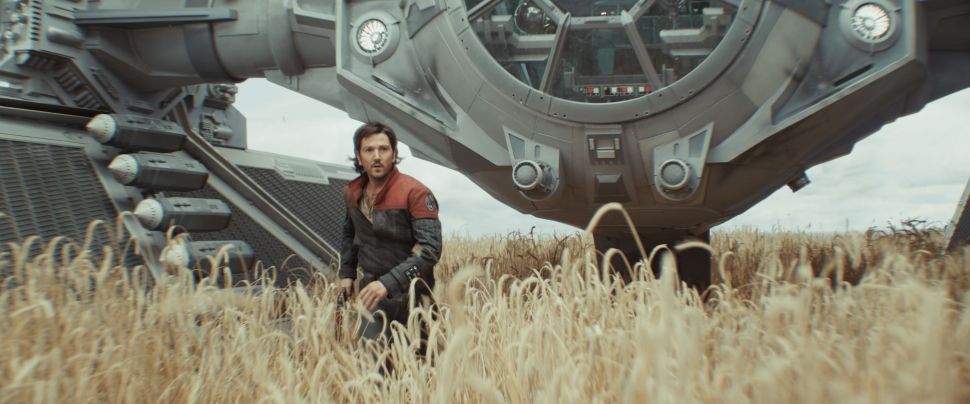Andor’s debut season was notable for staying connected to the Star Wars canon without being overly tethered to the ubiquitous franchise. The story, a prequel to 2016 film Rogue One, itself a prologue to Star Wars: A New Hope, found a delicate balance between requisite fan service and dynamic, relevant storytelling, thanks in large part to creator Tony Gilroy. Set five years before Rogue One, the 12 episodes followed spy and pilot Cassian Andor (Diego Luna) as he became an integral part of the Rebel Alliance, notably showcasing the politicians and bureaucrats on both sides of the growing Imperial conflict. It was a compelling approach in an oversaturated pop culture universe. The second season, somehow, eclipses that achievement in an impressive fashion, building a masterful narrative arc that is undeniable in its prescience to the rising fascism around the world.
Season Two begins a year after the events of last season’s finale, which saw a riot on Cassian’s home planet of Ferrix. Cassian escaped with Bix (Adria Arjona) and won over Luthen Rael (Stellan Skarsgård), an antiques dealer using his business as a front for rebel efforts. It’s now four years before the Battle of Yavin (BBY4, in Stars War lore) and Bix, Brasso (Joplin Sibtain) and other rebels are hiding out on Mina-Rau while Cassian runs into trouble stealing an Imperial ship from a testing facility. Senator Mon Mothma (Genevieve O’Reilly) is back on Chandrilla for her young daughter’s wedding, a necessary political machination to keep her illicit dissenting efforts under wraps. The Imperial forces are continuing their plans to build the Death Star, with Orson Krennic (Rogue One actor Ben Mendelsohn) enlisting a group of ISB officers to figure out how to mine Ghorman for essential minerals. One of these officers is Dedra Meero (Denise Gough), who suggests creating a local insurgency to control the peaceful textile-manufacturing planet.
The first few episodes—the season will be released weekly with three episodes at a time—set up the impending storylines. To cover several years of action, the season jumps ahead several times, a narrative technique that can be jarring, but never lags in its skillful coverage of every character. The introduction of Ghorman, a key location that has previously been mentioned in the Star Wars canon, brings in engaging new characters who tussle with Syril Karn (Kyle Soller) and team up with Vel Sartha (Faye Marsay). The writers also cleverly ret-com the arrival of Imperial droid K-2SO (Alan Tudyk). The world building is immense and incredibly detailed, down to the food served at parties on Coruscant. It feels real and textured, even when it’s clearly CGI being used to augment the locations. You immediately understand the Star Wars universe in a new way—a huge achievement considering the deluge of films and TV series in the past decade.
Gilroy, who wrote Season Two with Beau Willimon, Dan Gilroy and Tom Bissell, gives every character their due as the story nears the events of Rogue One. There are tragic losses and cathartic triumphs on both sides of the conflict. O’Reilly, in particular, gets a meaty storyline as Mothma prepares to speak out against Emperor Palpatine. But it’s Elizabeth Dulau, who plays Luthen’s skilled assistant Kleya Marki, who steals the show. Kleya becomes a fundamental player in the rebel uprising and Dulau’s performance is both memorable and heart-breaking. Luna, too, embraces the complexity of playing Cassian, a character we know doesn’t survive. Cassian finds himself in the midst of the events on Ghorman, which culminate in Episode Eight, one of the most captivating episodes of television to air in recent years. It’s difficult to emphasize exactly how relevant the episode feels without spoiling it, but anyone who has been watching the news will inevitably feel the jarring crush of how a fascist state can control and destroy its people for its own gain.
The challenge of Andor was always that knowledge of how the story ends for Cassian. Rogue One existed first, establishing Cassian’s fate, so the point of the series initially seemed to be to understand how he became that tragic hero. But it’s evolved into so much more than a simple prequel. Andor reflects on our ability to step up when freedom is threatened, examining what its characters will do but also asking the viewer the same thing. Gilroy and the writers couldn’t have known the outcome of the presidential election when they wrote Season Two, but the themes suggest they may have guessed. How will we rise in the face of our own impending Empire? “Rebellions are built on hope,” a character tells Cassian, echoing a famous quote from Rogue One and reminding us that giving up is never an option. It seems miraculous that this message comes from a show aired on Disney+, but we can only be grateful that it does.
The first three episodes of ‘Andor’ Season 2 premiere on Disney+ on April 22.

